Before we move on to celebrating the start of 2017 and forget about last year, let’s take one more deep dive into 2016. We saw tremendous Amazon sales growth overall, with some ups and downs and lessons learned. I have one exciting announcement which I will save for last. So if you do anything, make sure you skim to the very end…
The Current State of Jungle Stix
Jungle Stix is like a well-groomed house cat at this point–very low maintenance. I mostly let it chill in the corner and give it some love and nourishment (i.e. inventory replenishment) when I can.
Specifically, I spend about one to two hours per month on this.
If this were a full time business, I would certainly spend more time on it. Expanding the brand with complementary products, reducing the Pay Per Click cost per acquisition, maybe creating a niche site to drive traffic to my own website and build my own email list.
Having the business on autopilot at this point is really the beauty of the Fulfilment by Amazon business model. A bulk of the work was done upfront, by finding the right product, building relationships with a great supplier, and optimizing our listing so that we continue to get organic traffic.
So with that said, much of the sales that we see in this year was front-loaded work that we completed in 2015 and early 2016.
2016 – Overview of Sales
The top line: Jungle Stix sold $194,966 in 2016. This has far exceeded my expectations when I decided to sell the bamboo marshmallow sticks, and I’m sure the people who gave me funny looks did not expect that.
Here is a look at the sales on a monthly basis:
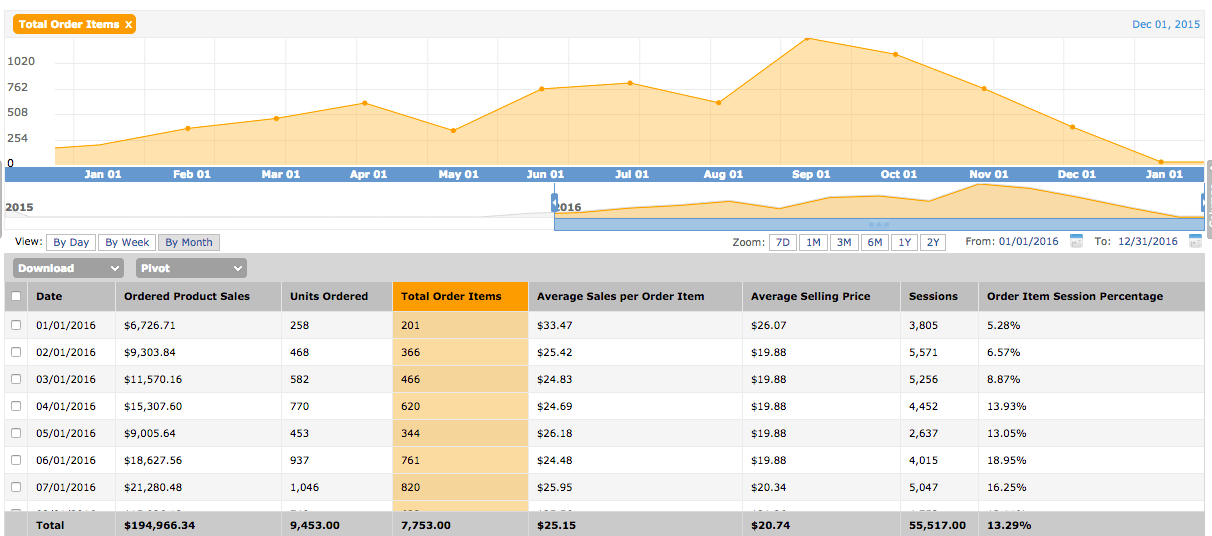
You can clearly see that the late summer and early fall months were our money makers.
It’s worth noting at this point that if you drill down and look at this on a daily basis, you can see that some periods of being out of inventory undermined our sales:
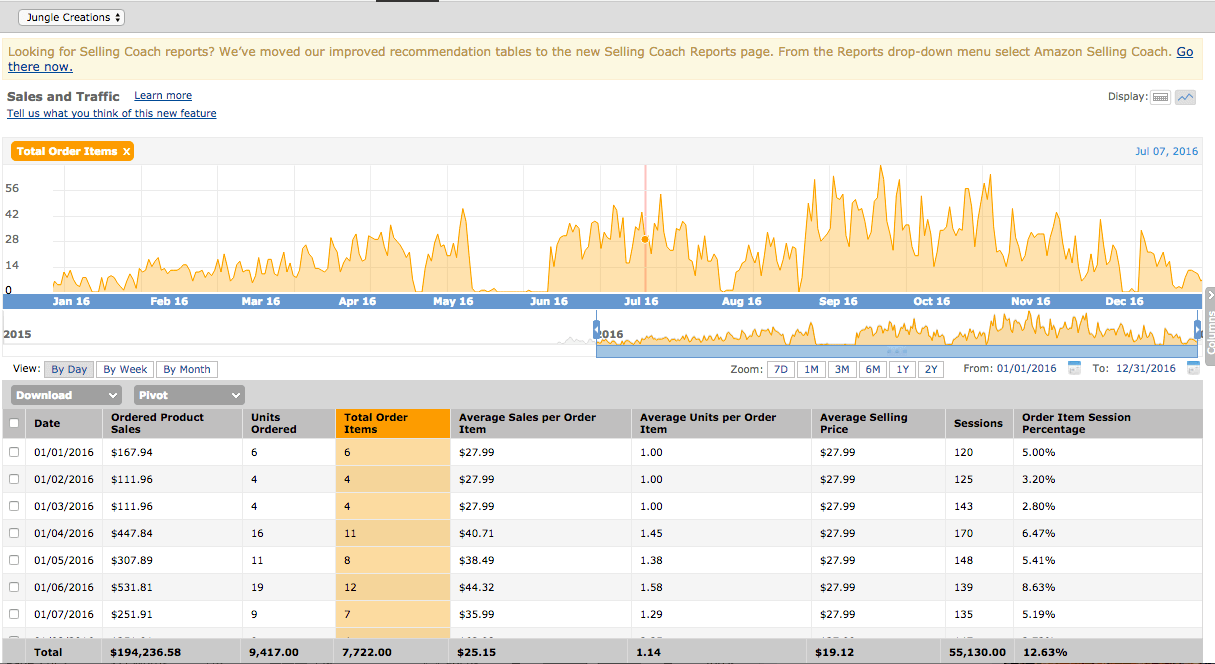
Just bear this in mind, we will discuss more on inventory management later.
Product Profitability
More important than the top line sales are the profits. The bottom line. The cheddar, the coin, the profit. For this, I reference Fetcher, the profit analytics tool that we launched recently.

*Note – Fetcher calculates “true” sales, Seller Cetral doesn’t remove lost revenue from promotions, where Fetcher does. That is why you see a discrepancy between revenue in Seller Central vs. Fetcher.
At a glance, you can get a snapshot of Sales, Expenses, and Profits.
What can we do with this information going forward in 2017? There are two ways to improve the profit margin—increase sales, or reduce expenses. Obviously both would be ideal, but I think that reducing expenses is an easier lever to pull.
In Fetcher, I like to drill down into the ‘Costs’ section on the dashboard. Here is a high level overview of everything that is classified as an expense:
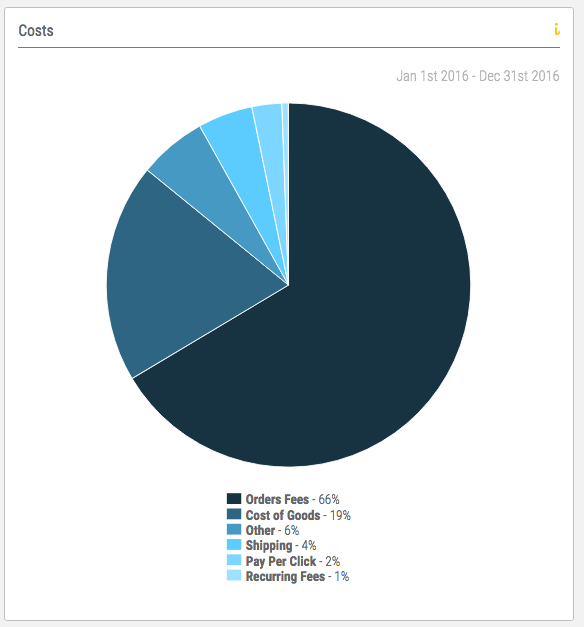
The order fees are certainly hefty, $96,000 and almost two-thirds of all expenses.
If I click on that part of the pie chart, I can see how those “Orders Fees” are comprised:
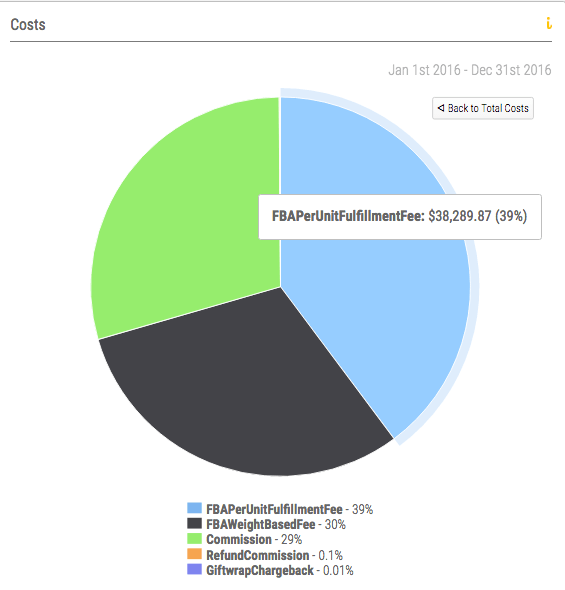
This is a difficult expense to reduce though, there is not much that I can do. This is partially due to Jungle Stix being an oversized product. At 36” long, it totally disregards my “shoebox” test—anything under two pounds that can fit in a shoebox is the ideal size. And these costs are why I think that it is so important!
That said, there is still a way to reduce some of these fees, which I will address with Storage Fees.
Supplier Relations
From our very first order, I have developed a great relationship with our supplier. This is partially due to luck, and partially due to the vetting process when I was looking for suppliers.
I am very happy with our supplier and the quality of the product. Remember, I have never even held Jungle Stix myself (outside of the initial sample), but judging by the reviews this is a consistently high-quality product.
To reinforce this fact, we can look at the Refund Rate in Seller Central, which averages around 1.5%, which is below what most Amazon sellers see (most products on Amazon have a 3% to 6% refund rate).
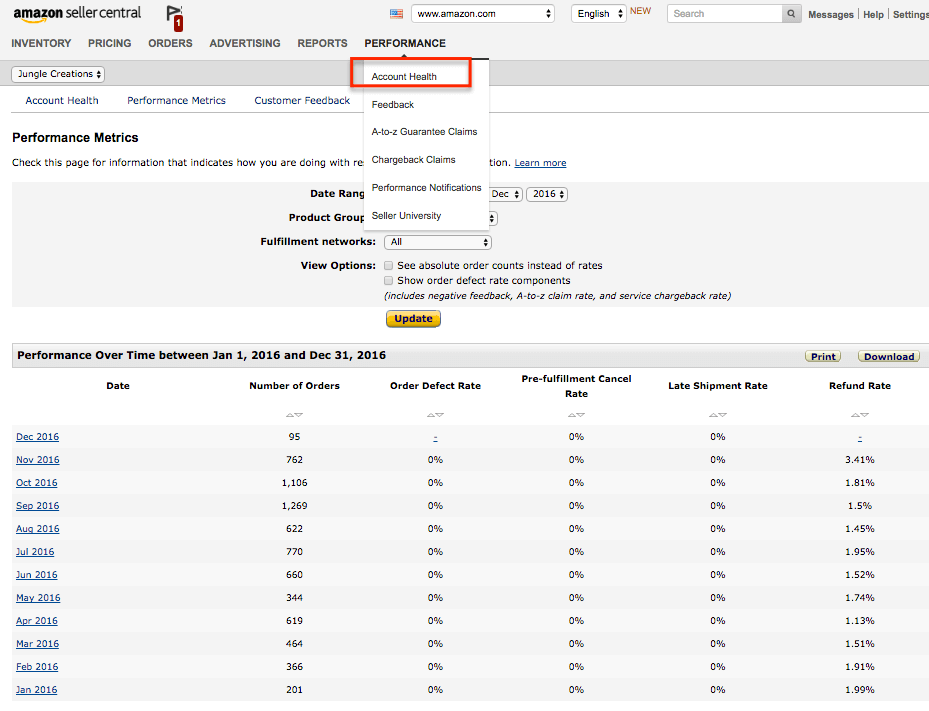
I have also been able to negotiate better product costs with my supplier as I have proven that we are a serious business with repeat orders. My cost per unit is now $2.90 per product, with a landed cost (i.e. including shipping) is $3.67. This is how the cost breaks down:

Pay Per Click Advertising
Our pay per click (PPC) campaigns have done quite well this year. Amazon’s pay per click platform is a great way to generate incremental sales and increase sales velocity with a cost-effective cost per acquisition.
I definitely could have improved the Average Cost of Sale (ACoS) if I had spent time on optimizing these campaigns, but they were pretty much churning out sales on autopilot for the last few months.
My pay per click strategy: run maximum bids on main keywords (like “bamboo marshmallow sticks”) so that I get top positioning for my sponsored ad, to complement my organic listing (which generally is at the top of the organic listing). This increases “real estate” at the top of the page, so a user is more likely to click on my product.
Here is how my PPC campaigns have performed in the past 90 days, as displayed in Fetcher:
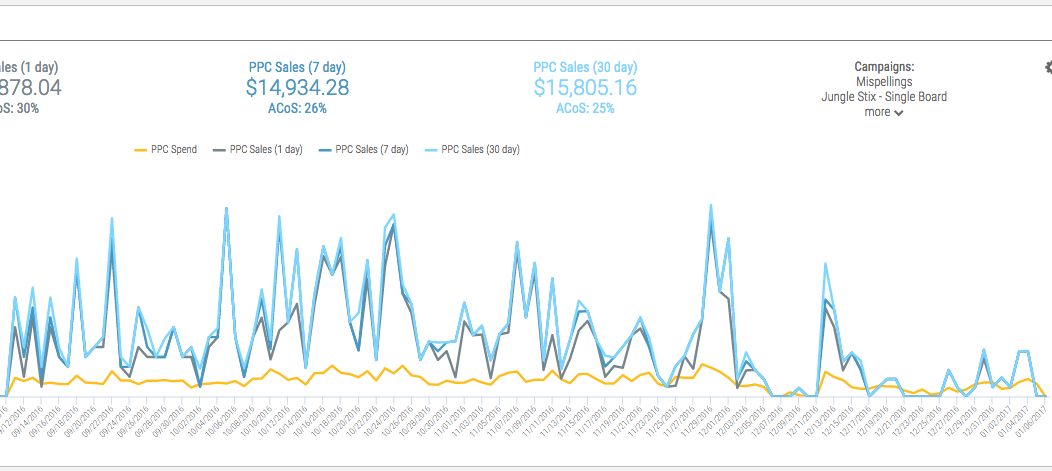
Incremental PPC sales
What I find very interesting with this chart is that you can see the sales attributed to a sponsored ad for a 1 day, 7 day, and 30 day window. This means that the ad is credited for the conversion for a period of time after the customer clicks on the ad, in a 1 day, 7 day, or 30 day window.
Fetcher captures these different conversion windows, and its effect on ACoS. This is very interesting. Basically, there has been $2927 more in incremental sales if we extend the conversion window out from 1 day to 30 days, and it improves the ACoS from 30% to 25%.
So if a shopper clicks on your ad and puts the product in their cart and doesn’t checkout for another 2 weeks it’s a 30 day PPC sale. The ad still gets credit for the sale. Ultimately, this means that your pay per click campaigns might be performing better than they realize and should be adjusted accordingly. This is certainly the case for Jungle Stix. It would be interesting for you to check this out for your own Amazon PPC campaigns.
The Importance of Fee Management
As you can see from the break down in fees, you have to pay the pied piper. For Amazon sellers, there are now four certainties in life: death, taxes, change…and Amazon fees.
So yes, Bezos is going to claim his fees on most everything…that he knows about. How can we reduce some of these FBA fees?
With some planning and foresight, we can reduce fees by managing inventory properly. More specifically, if you plan to reduce idle inventory in the 4Q when Amazon bumps its storage fees, you can save yourself a nice chunk of change.
In order to save money on fees, plan to reduce idle inventory in the 4Q when Amazon bumps up storage fees.
Let me explain…
Every month you pay storage fees based on the average volume in the fulfillment centers during the month. However, every year when Amazon increases their fees, you as the seller take the hit. It is been a yearly thing that Amazon raises storage fees every 4Q, but this year in 2017 there are some rumors that it may be even earlier. You can see the latest 2017 FBA US fee changes here.
These are the Monthly Inventory Storage Fees:
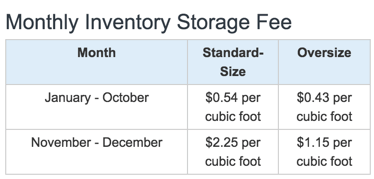
In addition to these monthly fees, there are long term storage fees. And these can be dangerous! Fees add up and eat into profit margins like a Jurassic Park velociraptor. Yeah, that nasty. In fact, Amazon’s is doing its biannual inventory cleanup this February 15, so now is as good a time as any to investigate your long term inventory situation. You can learn more about it here, or just see the painful fees here:

This 4Q I was very aware of how much inventory I had, and I tried to minimize the long term storage fees because I had gotten hit badly in the past. And I know sellers that have lost tens of thousands on these fees as a result.
Anyway, the takeaway here is be very careful about managing inventory, especially with long term storage fees in the upcoming year! As more sellers jump on Amazon and warehouse space becomes more limited, fees will invariably increase.
Inventory Management
I have covered this before (in fact we did an excellent webinar with Jeremy Biron, CEO of Forecastly which you can watch here), but Inventory Management is the unsung hero of your Amazon profits.
You can just take a look at my annual sales on a daily basis:

See those days when sales plummet to 0? Those are out-of-stock days.
In total in 2016 I had 29 days of out of stock, which depending on your sales assumptions is anywhere from $10k-$15k in sales. That is not including the effect the out-of-stock had on the Best Seller Rank, organic rank for the main keywords, and negative impact on sales velocity and sales history.
Going forward, I believe that if I monitor my manufacturing lead time (the number of days it takes from placing an order to arrival at the Amazon distribution center) and my sales velocity, I will be able to manage my inventory much better.
Amazon Terms of Service Change
We launched Jungle Stix in December of 2015, which is when you could successfully launch a product by doing promotional giveaways in exchange for product reviews, and catapult up the Best Seller Rankings.
Oh, the good old days. Since early October, Amazon has prohibited incentivized reviews. We did an in-depth study recently to determine exactly how bad it affected sellers. The results are quite interesting—but in short, it mostly affected sellers who were gaming and abusing the system. Therefore, most sellers were not affected, and what’s better, the change is a positive step forward for Amazon sellers and Amazon in general.
The new challenge: how will new products launch and get product reviews?
I believe that it will be a game of basic blocking and tackling. Provide a great product, solid customer service, build customer relationships and brand loyalty.
Amazon obviously makes it hard to build customer relationships, as the people who purchased your product on Amazon are ultimately Amazon’s customers!
My strategy now relies on follow-up email campaigns to ask customers for product reviews.
But instead of telling you how to launch products post-TOS change, I want to show you… which brings me to discuss what’s next with Jungle Stix and our case study.
Next Steps for Our Case Study
I have been really excited about this idea for months, but haven’t really said anything yet. And I’m sure that my team is going to kill me for spilling the beans early, but: we have a sequel to this case study, which may legitimately be called “The Ultimate Case Study”.
I will be sharing more details in the near future, but I think it is so important to share lessons and insights on the constantly evolving Amazon marketplace. Stay tuned, we will be coming out with more details within the month…
The plan is to find and launch a product on Amazon, similar to Jungle Stix. However, as the circumstances have changed in just the past year, we are going to expand our revenue streams to include other sales channels. Our own ecommerce store, Amazon affiliate sales… maybe even try eBay?
It will be really exciting, so if you have ideas of what you want to see, please drop them in the comments section below! It’s going to be a fantastic learning experience for everyone involved!
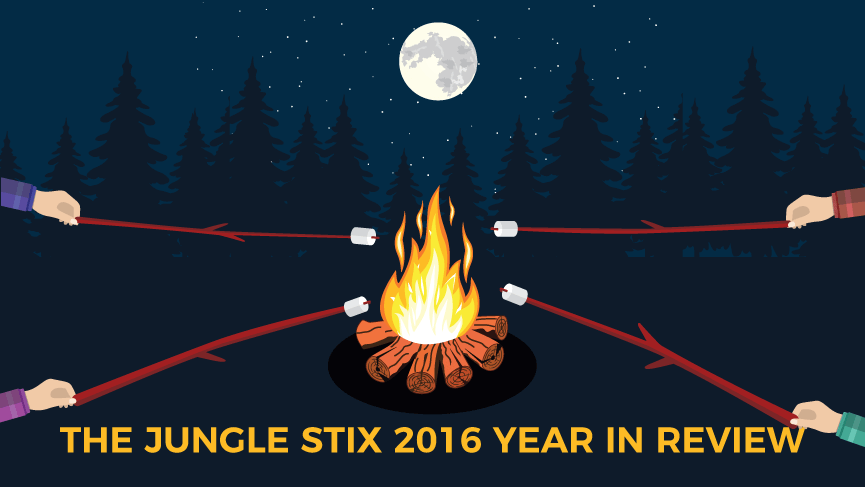
 9 Comments
9 Comments
9 comments on “Jungle Stix 2016 Annual Report: A Year In Amazon Sales Growth”